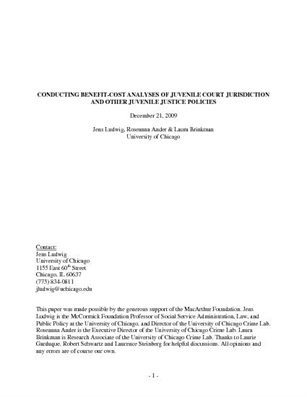Conducting Benefit-Cost Analyses of Juvenile Court Jurisdiction and Other Juvenile Justice Policies
Published Dec 21, 2009, Jens Ludwig, Roseanna Ander & Laura Brinkman
Download
(194 KB)

Concern about juvenile crime in the 1980s led most states across the country to enact policy changes that made it easier to transfer juvenile arrestees into the adult criminal justice system (Hahn et al., 2007, p. 2). For example the number of states with statutory waiver laws, which require certain types of crimes to be automatically tried in the (adult) criminal courts, more than doubled from 1979 to 2003, from 14 to 31 (Redding, 2008). Over the past 15 years, fully 13 states have lowered the maximum age of juvenile court jurisdiction to below 18, though this trend has been reversed in some states in recent years. Still, the expansions of transfer laws lead to an increase in youth being tried and sentenced in the adult corrections system. New admissions for youth under 18 into state prisons increased 22% from 1985-2002 (OJJDP, 2006).
Increasingly constrained criminal justice budgets have created a second motivation for transferring juvenile arrestees to the adult system – costs. The average annual cost of detaining a juvenile offender is estimated to be nearly $88,000 per year, nearly four times the estimated annual cost of keeping an adult in prison. It is natural that many policymakers might conclude that shifting young arrestees from the juvenile to adult criminal justice systems could help conserve resources that could be devoted to other pressing social needs.
Yet a key point of our paper is that this type of informal benefit-cost analysis, which focuses on comparing the annual costs per bed in the juvenile versus adult system, is far too narrow. After all, a key reason why the cost per detainee in the juvenile justice system is so much higher than in the adult system is because the former is intended to provide more intensive educational and therapeutic services, and also employs higher staff-to-resident ratios to provide a safer, more secure environment for residents and minimize any “brutalization” effects from detention. As a result we might expect, or at least hope, that handling juvenile cases in the juvenile rather than adult systems could potentially lead to lower rates of recidivism, increased schooling attainment, improved health, and greater success in the (legal) labor market. These potential outcomes not only improve the well-being of juvenile arrestees themselves, but also have important consequences for the well-being of the rest of society as well. Focusing only on the difference between the juvenile and adult systems in the costs per bed can lead to misguided public policy decisions that are not in the best interests of the American public.